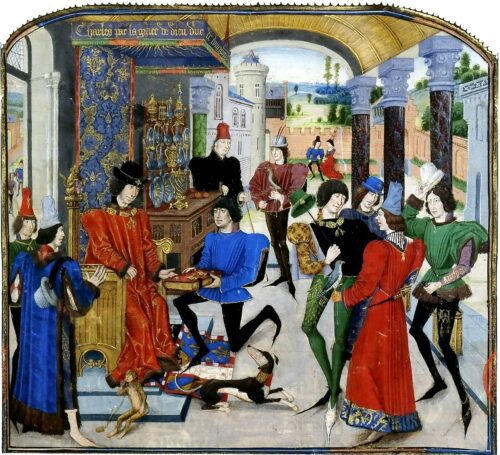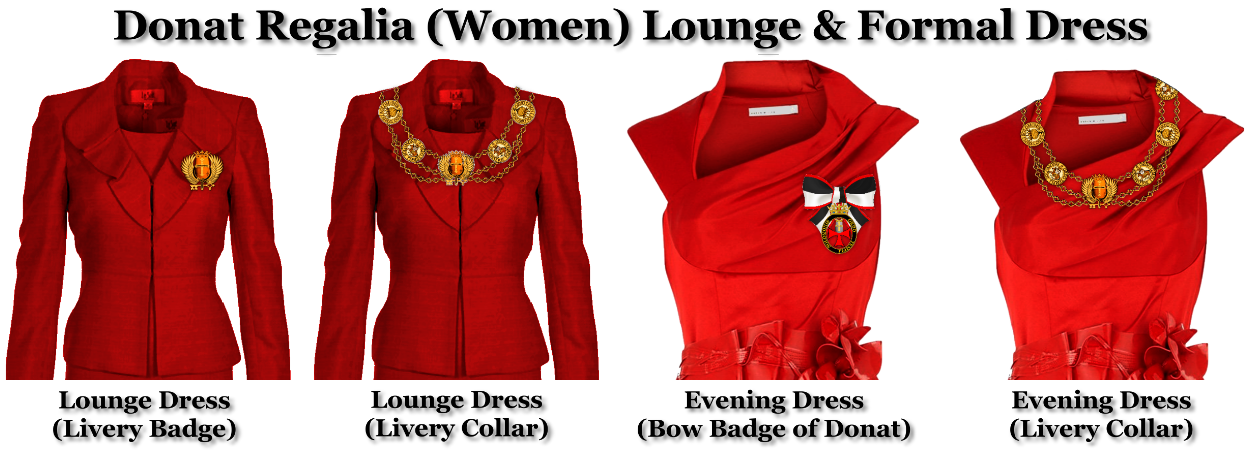 The honourary monastic title of “Donat” comes from the 11th century Latin word ‘donatus’, which means a person who is “devoted” to a monastery or Holy cause. It also derives from the Latin ‘donare’, meaning to grant or donate as a Patron financial sponsor. Traditionally, the position of Donat is an official appointment, as honourary recognition of a Patron sponsor of the Order, who makes a substantial financial contribution in support of the missions and good works of the Order.
The honourary monastic title of “Donat” comes from the 11th century Latin word ‘donatus’, which means a person who is “devoted” to a monastery or Holy cause. It also derives from the Latin ‘donare’, meaning to grant or donate as a Patron financial sponsor. Traditionally, the position of Donat is an official appointment, as honourary recognition of a Patron sponsor of the Order, who makes a substantial financial contribution in support of the missions and good works of the Order.

Frontpiece of ‘Fait et Gestes d’Alexandre’ of Vasco de Lucena, illuminated by Loyset Liedet (c.1450), depicting Nobility Patron donating a valuable book to the Royal Library, in Biblioteque Nationale de Paris (No. 22547)
Donat status as chivalric membership was practiced from medieval times in the Hospitaller Order of Saint John (later of Malta), and in Monastic Orders of the Church. This was adopted by the Order of Saint John in France from 1820 AD, and by the British Venerable Order of Saint John established by Queen Victoria in 1888 AD. It was also preserved in the modern Sovereign Military Order of Malta (SMOM) of the Vatican, which uses the full title “Donat of Devotion”.
Being a Donat of Devotion is an alternative form of membership for full participation in the Order. This status is granted to a Patron who is not a serving member of the Order, and thus does not need to pledge the Commitment of Service nor profess the Vow of Chivalry. If a Donat later becomes a Sergeant or Adjutante, Knight or Dame, or Crown Officer in the Order, then the Donat status would be replaced by the chivalric or sovereign position and title.
The Code of Chivalry of 1066 AD essentially requires to “Give generously and wholeheartedly, for meaningful impact.” (9th Pillar) [1].
The Templar Code of 1150 AD mandates to “Use one’s strength only to protect and uphold the weak” (4th Pillar).
That is based on the Temple Rule of 1129 AD, which commands that the strong (or wealthy) must “give thanks to God” for their fortune, by caring for the less fortunate (Rule 34), because “God holds both the strong and the weak equal in the name of charity” (Rule 38). It requires all Templars to actively donate to the Order “all offerings and all forms of alms” as much as possible (Rule 64) [2].
Therefore, Donats of Devotion manifestly fulfill a core element of the substance of authentic Chivalry, and one of the primary Templar principles. Accordingly, Donat status is not merely an exception, but represents rightful membership earned by genuine merit, as a Templar Brother or Sister.
In the Order of the Temple of Solomon, being a Donat of Devotion holds a special prestige, in the time honoured tradition of influential families of royalty and nobility being Patron sponsors to the Knights Templar. Donats were always the driving force of the historical accomplishments of the Templar Order, giving it financial and tangible resources to achieve those Holy Quests which characterized European civilization for many centuries.
Accordingly, the Sergeants and Adjutantes, Knights and Dames of the Order hold Donat members in the highest regard, respected as their greatest benefactors who make the chivalric and charitable missions possible through support of the Templar Order. Donats participate in the Order in full membership, with access to all Templar events and activities.
Donats of Devotion are equally Templar Brothers and Sisters of the Order, in their own right, for the merit of their important role. Both male and female Donats use the same formal title “Donat of Devotion”. Donats can also use the alternative or supplemental title “Patron of the Temple of Solomon” (Patronus / Patrona Templi Solomonis).
 According to tradition evidenced by the Vatican and British Royal Orders, there is only one class of Donat, with no further levels. It is significant that historically, the chivalric regalia for Donats is a Neck Riband Badge (men) or Breast Bow Badge (women), which under the customary rules is the form worn by Knights and Dames. This evidences that Donats of Devotion are not considered “less than” Knights and Dames, but rather are a parallel and alternative form of membership in the chivalric Order, honoured and decorated equally as the Knights and Dames.
According to tradition evidenced by the Vatican and British Royal Orders, there is only one class of Donat, with no further levels. It is significant that historically, the chivalric regalia for Donats is a Neck Riband Badge (men) or Breast Bow Badge (women), which under the customary rules is the form worn by Knights and Dames. This evidences that Donats of Devotion are not considered “less than” Knights and Dames, but rather are a parallel and alternative form of membership in the chivalric Order, honoured and decorated equally as the Knights and Dames.
 In the Order of the Temple of Solomon, Donats are issued the same design of Livery Badge and Livery Collar as all other members. The Livery regalia for Donats is made of the same “bronze” metal as used for Grand Officers, as a reminder of the traditional close relationship which noble Patrons always hold with the Grand Mastery of the Order.
In the Order of the Temple of Solomon, Donats are issued the same design of Livery Badge and Livery Collar as all other members. The Livery regalia for Donats is made of the same “bronze” metal as used for Grand Officers, as a reminder of the traditional close relationship which noble Patrons always hold with the Grand Mastery of the Order.
By customary heraldic rules, the Donat Badge consists of the chivalric Badge of the Order, with the upper arm or top portion of the primary symbol removed, and replaced by a decorative or symbolic element. The heraldic significance is not that a portion is removed, but rather that this highlights the base of the primary symbol, emphasizing the key role of Donats as the “foundation” of any chivalric Order.
Donats do not wear the Templar Uniform, because they are not in active service on missions and operations of the Order as an official institution, but rather are the Patrons supporting its capabilities. Accordingly, Donat regalia is worn only with the civilian forms of the various dress codes.
The Donat Badge and its usage complies with the Rules of Regalia of 1672 AD [3] established as the international standard system in 1921 AD [4], following the precedent of other 12th century chivalric Orders [5]. The Order also reestablished proper use of the medieval Livery Badge and Livery Collar, as official insignia reserved for Chivalry and Nobility [6] [7], which were authorized to wear “at all feasts and in all companies” with all dress codes [8].
Templar Donat regalia provides a traditional yet conservative look, which is practical for diverse situations, including in modern business and social settings. While appropriate and minimalist, the Donat regalia carries distinctive prestige, following recognized chivalric rules for visible legitimacy.
As a result, Templar Donats of Devotion can rightfully use the chivalric Donat Badge, Livery Badge and Livery Collar with smart casual dress, business dress and evening wear, expressing their official Templarism in diverse situations.

DONAT Regalia (Men)

DONAT Regalia (Women)
Regalia Purchased Separately – Regalia must be purchased separately, after being installed as a Templar Donat of Devotion in full membership. Regalia costs are not included in the subscriptions or donations made by members of the Order.
Illustrations May Enlarge Sizes – For the purposes of Illustration, regalia accessories and insignia may appear larger than their actual size proportional to the clothing, for better visibility of detail. Actual sizes are strictly and precisely in accordance with the international standard rules as used by all governments and legitimate chivalric Orders.
 Historically, the humanitarian and geopolitical missions of the Order of the Temple of Solomon were made possible primarily by nobility and merchants donating entire fortunes, including even castles. Thus, there is a strong tradition of making substantial non-profit donations to projects supported by the Templar Order.
Historically, the humanitarian and geopolitical missions of the Order of the Temple of Solomon were made possible primarily by nobility and merchants donating entire fortunes, including even castles. Thus, there is a strong tradition of making substantial non-profit donations to projects supported by the Templar Order.
 In the modern era, the Templar Order continues to be a professional organization responsible for serious missions for the benefit of humanity. Economic support from Donats of Devotion thus continues to be of great importance, to ensure that the humanitarian missions can be effectively advanced, with real-world results, for meaningful worldwide impact.
In the modern era, the Templar Order continues to be a professional organization responsible for serious missions for the benefit of humanity. Economic support from Donats of Devotion thus continues to be of great importance, to ensure that the humanitarian missions can be effectively advanced, with real-world results, for meaningful worldwide impact.
Donats of Devotion continue the tradition of an important role in the Templar Order, not only to give their own sponsorship contributions, but also to assist the non-profit fundraising efforts of the Order through their networks of other potential sources of grants and sponsorship.
In many cases, the Order does not engage in non-profit fundraising for itself, but rather requests donations to be made directly to independent third-party non-profit and inter-governmental institutions, for various humanitarian projects which the Order supports.
 For membership in the Order of the Temple of Solomon, Templar Donats of Devotion do not need an “Induction” pledging the Commitment of Service (as for Sergeants and Adjutantes), and do not need an “Investiture” professing the Vow of Chivalry (as for Knights and Dames). Postulant studies are not required, although Donats have full access to the complete collection of educational materials provided by the Order.
For membership in the Order of the Temple of Solomon, Templar Donats of Devotion do not need an “Induction” pledging the Commitment of Service (as for Sergeants and Adjutantes), and do not need an “Investiture” professing the Vow of Chivalry (as for Knights and Dames). Postulant studies are not required, although Donats have full access to the complete collection of educational materials provided by the Order.
Rather, based upon a meaningful donation of practical impact, as a visible expression of dedication to Templar principles, a Donat of Devotion receives “Establishment” into the Order by decree of the Grand Mastery, becoming a Templar Brother or Sister in full membership.
True to the titled phrase “of Devotion”, Donat status is not simply “for sale”, does not have any fixed “price tag”, and cannot be obtained solely by reason of donating a certain amount. The essential element, and controlling criteria, is that the Patron sponsorship must represent a meaningful demonstration of spiritual devotion and moral dedication to supporting the humanitarian good works of the Templar Order.
When Jesus “saw the rich men casting their gifts into the treasury”, and a poor woman “threw in two mites”, Jesus called all his Disciples and declared to them: “This poor widow hath cast in more than they all: for all these have of their abundance cast in unto the offerings of God; but she of her [poverty] hath cast in all the living that she had.” (Luke 21:1-4; Mark 12:41-42) [9]
By these principles: A smaller contribution, which is relatively and proportionately significant for the individual, and is intended to empower the Order to accomplish an important smaller project of greater impact to its larger missions, can qualify as a Donat of Devotion; A much larger donation, made only by convenience within the limits of a tax deduction or primarily for the benefits of tax deductibility, without additional forms of support or cooperation, might not qualify for Donat status.
To become a sponsoring Donat of Devotion, one must first submit a Curriculum Vitae (“CV”), which should be as complete and with as much detail as possible, to enable the Grand Mastery to get to know the candidate as a potential VIP member of the Order. One’s request should also indicate planned amounts and capabilities for non-profit donations to the missions of the Order.
(Substantial donations or contributions, which have major impact on strategic humanitarian missions of the Order on an international scale, when combined with other forms of support and cooperation, may qualify a Donat of Devotion to additionally be granted a Title of Nobility. Nobility titles can be issued by the official sovereign authority of the Templar Order under customary international law, either on a lifetime or hereditary basis, as may be appropriate.)
Learn about Modern Templar Missions of the Order.
Learn about the Codes of Chivalry for Templar missions.
[1] Emile Leon Gautier, La Chevalerie (1883), translated in: Henry Frith, Chivalry, George Routledge & Sons, London (1891), reconstructed from historical sources since ca. 1066 AD.
[2] Henri de Curzon, La Règle du Temple, La Société de L’Histoire de France, Paris (1886), in Librarie Renouard, Rules 34, 38, 64.
[3] Elias Ashmole, Institution Laws and Ceremonies of the Most Noble Order of the Garter, Hammet Publishing, London (1672), with engravings by Wenceslaus Hollar (33 plates), digitized by Folger Shakespeare Library.
[4] Herbert Arthur Previté Trendell, Dress and Insignia Worn at His Majesty’s Court, Harrison & Sons, for Lord Chamberlain’s Office, London (1921).
[5] Noel Cox, The Robes and Insignia of the Most Venerable Order of the Hospital of St John of Jerusalem, Arma: Journal of the Heraldry Society of Southern Africa (1999-2000), Issue 5.2.
[6] Peter Brown, A Companion to Chaucer, Wiley-Blackwell (2002), p.17.
[7] Chris Given-Wilson, Richard II and the Higher Nobility, in Anthony Goodman & James Gillespie, Richard II: The Art of Kingship, Oxford University Press (2003), p.126.
[8] Susan Crane, The Performance of Self, University of Pennsylvania Press (2002), p.19.
[9] New Testament, Authorized King James Version (AKJV), Cambridge University Press (1990), Luke 21:1-4, Mark 12:41-42.
You cannot copy content of this page
